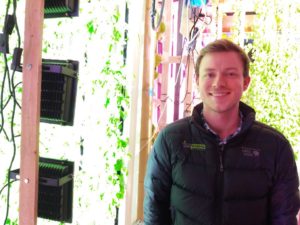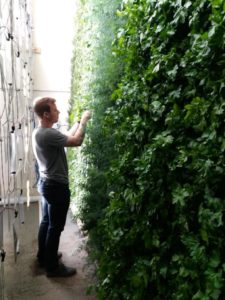
Nik became interested in growing crops hydroponically while studying accounting and finance in college.
Nik Bouman, is a hydroponic herb farmer in Anchorage, Alaska. With Alaskans relying heavily on food imports, Nik’s CityFarms Alaska is providing locally-grown, fresh options for area residents.
Unique Challenges
Nik became interested in growing crops hydroponically while studying accounting and finance in college. Hydroponic farmers grow their plants without soil and use constant circulation of water and nutrients.
He saw potential for a business, given the unique challenges Alaskans face when it comes to purchasing fresh foods. According to the Alaska Food Policy Council, 95 percent of Alaska’s food is imported.
“Up here, the produce that you buy usually is a few weeks old, just because it has to be shipped up,” he said. “It’s a long supply chain to get up here. The freshness is terrible, and things don’t really last that long.”
When looking to start his business, Alaska’s daylight also became a factor.
“I thought about a having a greenhouse, but in the winter time, we have so little sun. I prefer this consistency,” Nik said. “Being able to have the same quality of product all year is pretty valuable from the business side of things.”
Growing from the Garage
In the summer of 2017, Nik set up a hydroponic system in his parent’s garage and began growing his largest crop, basil, along with seven other types of herbs.
“I picked basil because it can’t be refrigerated, and it doesn’t ship very well,” he said. “So, it was basically the thing that gave me the best advantage and easiest way to make money.”
After a year of growing in the garage, Nik was able to expand his sales into multiple grocery stores in Anchorage and surrounding communities.

Needing to increase his growing capacity, Nik moved his operation into a 1200-square-foot warehouse space in 2018.
Needing to increase his growing capacity, Nik moved his operation into a 1200-square-foot warehouse space in 2018. With the help of a low-interest microloan from USDA’s Farm Service Agency, he was able to purchase all new equipment – including grow lights, towers, water tanks, and pumps – for his expanded operation. Nik says this has allowed him to quadruple his business.
Cost of Doing Business
Another unique challenge Nik faces is the cost to have his business supplies shipped in.
“It’s expensive to ship stuff like packaging and equipment up here,” he said. “Packaging is the biggest one. We use a lot of it and have to get it shipped up, so it usually costs like 25 to 50 percent more than it would for anyone else.”
To help offset some of his costs, Nik participates in FSA’s Reimbursement Transportation Cost Program for Geographically Disadvantaged Farmers and Ranchers. This program helps producers in Alaska, Hawaii, Puerto Rico, and other insular areas regain a portion of the cost of transporting agricultural commodities or their inputs.
Mentors Matter
Nik taught himself the ins and outs of hydroponics online through YouTube videos and Upstart University, an online educational platform. He also shadowed another hydroponic grower to learn more about the systems.
“One thing that helped me a ton was knowing or meeting another farmer – someone who does a similar thing that you’re planning to do, and use them as a mentor,” he said. “To get advice from an actual farmer, you get some really good information.”

Nik’s largest crop is basil, which he sells locally along with seven other types of herbs.
USDA has partnered with SCORE, the nation’s largest network of volunteer expert business mentors and resource partner of the Small Business Administration. Agricultural producers can receive free business mentoring to move from getting started to profitability and growth.
In the future, Nik hopes to add crops and additional capacity. As for now, he’s satisfied seeing his products on grocery store shelves.
“When people tell you ‘your basil tastes really good,’ ‘it’s so fresh,’ that’s probably the most satisfying part,” Nik said. “It tells you that your business is actually adding value.”
More Information
USDA offers a variety of risk management, disaster assistance, loan, and conservation programs to help agricultural producers in the United States weather ups and downs in the market and recover from natural disasters as well as invest in improvements to their operations. Learn about additional programs.
For more information about USDA programs and services, contact your local USDA service center.
Join the Conversation
For the digital version of this blog, visit #FridaysOnTheFarm
Follow the #FridaysOnTheFarm story series and other news you can use on farmers.gov and our social media channels: Twitter, Instagram, YouTube, Flickr, and Facebook.
Story Credit: Dana Rogge, USDA
Photo Credit: CityFarms Alaska & USDA






One Response to Keeping it Fresh in the Last Frontier